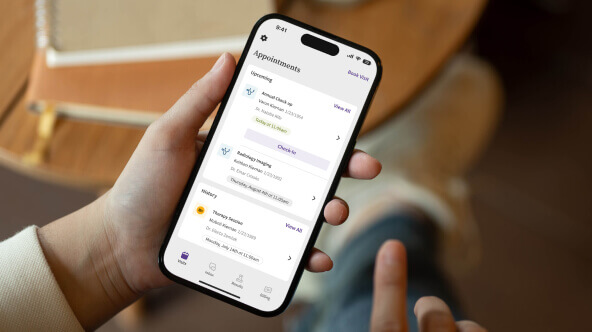North Country Family Health Center
FQHC increases effiency, patient satisfaction with modern documentation tools
Jan. 01, 2025Modern patient engagement tools, efficient documentation, and reliability with athenaOne
Needed modern engagement tools to keep up with patient population
Unable to complete documentation by end of day
On-premise solution was unreliable and inflexible
athenaOne®
athenaTelehealth™
Results
Modern patient engagement tools increased patient satisfaction
Efficient documentation with customized encounter templates
Cloud-based solution offers the reliability and flexibility needed to support off-site COVID-19 vaccination clinics
3.9
minutes decrease in average encounter documentation time
45
mouse clicks on average reduced per encounter
North Country Family Health Center (NCFHC), a federally qualified health center in Northern New York, has always been hyper-focused on its patients. “We’re open to everybody in the community, but our focus is on how to serve those that often have barriers to healthcare and reduce those barriers,” said Joey Marie Horton, CEO.
When the NCFHC team sat down to map out a five-year strategic plan, it comes as no surprise that many of the initiatives revolved around improving the overall patient experience. “Prior to even having a conversation about an EHR conversion, we had in our strategic plan the initiative to become more patient-focused and to continue to make access to care easier for patients, as well as utilizing technology for patients to engage with us,” Horton explained. “We wanted to be able to compete with the private market in the community and meet the needs of a very virtual-based population.”
Even though NCFHC wasn’t necessarily thinking about moving off their previous EHR, the team realized that converting to athenaOne would help them achieve their five-year goals. “When we saw the athenaOne demo and saw all the patient engagement capabilities, that was a point where we said, ‘This really does fit within our strategic plan,’” Horton said.
Using technology to meet strategic goals
Above all, NCFHC wanted to prioritize modern ways of engaging its patients, who range from the military community at nearby Fort Drum to young parents who want to do everything on their smartphones. “Parents don’t want to wait on a call to talk to somebody about scheduling an appointment,” Horton said. “They want to just do it on their smartphone right now, when they want to.”
NCFHC found modern patient engagement capabilities, like booking an appointment via a portal or the ability for patients to message their provider, in athenaOne. Since going live, NCFHC staff can now send texts to patients offering appointments within the hour. “To be able to have functionality that would allow patients to engage more via a smartphone was really important to us,” Horton said. “It gives us a strategic tool to grow our practice, so that we’re serving everybody in the community.”
Moving to the cloud was another important technology advancement, providing extra peace of mind around reliability. “We did previously have issues with downtime, so having athena state that they have a 99.7 percent uptime guarantee was very enticing for us, given our past issues,” Horton said. NCFHC providers can provide uninterrupted care to patients without worrying about downtime — both day-to-day and in times of crisis. “When the power goes out, like it did last Friday, we can pull in hot spots and providers are still able to document,” Horton explained.
The cloud-based nature of athenaOne also offers increased flexibility. NCFHC was able to run COVID-19 vaccination clinics off-site, without worrying about needing to pre-plan VPN connections. “Being able to be portable has helped us redesign how we provide care because of COVID,” Horton said. “That has been amazing.”
Creating new efficiencies across the organization
Beyond mapping well to NCFHC’s strategic goals around modern patient engagement, athenaOne also enables more efficient documentation with fewer clicks, allowing providers to focus more on patients. “What we heard from providers with our previous documentation was that there were too many clicks,” said Barb Fargo, clinical operations officer. “I think there’s definitely a more streamlined process for providers to document. It takes less time and you’re not clicking as much as you had previously.” Since switching to athenaOne, NCFHC has experienced a decrease in average encounter documentation time from 10.7 to 6.8 minutes, and NCFHC providers are using an average of 52 mouse clicks per encounter, down from an average of 97 clicks previously.
Another reason why documentation is more efficient is that providers can customize their encounter templates. “One of the advantages with athenaOne is that you’re able to customize your documentation,” Fargo said. “Each provider can develop their template specific to them and what they like. If a provider sees somebody with a sore throat and the chart automatically populates because it knows what they usually do, that increases the amount of face-to-face time the provider has with the patient, rather than worrying about documentation.”
“We always had a goal for the provider to finish their documentation by the end of the day,” Fargo explained. “That used to be very challenging. Now, I am seeing that can easily be accomplished.” Some providers have also taken advantage of free one-on-one coaching calls through athenahealth’s Coaching and Training Services to learn how to document even more efficiently, according to Fargo.
Horton adds that from her perspective as CEO, it’s helpful that athenaOne provides insights she needs to improve the organization’s performance. Horton can now see data on how providers are faring with documentation, like how many clicks and keystrokes they use per encounter, same-day encounter closure rate, and macro use. “For us to be able to have data and reporting on the backend to show that it’s working, or these providers need a little extra assistance, is really helpful for us,” Horton explained.
Horton also explained that athenaOne helps minimize the administrative burden for office staff, freeing up additional time for the team to spend on higher-level work. NCFHC staff have noticed time savings across the board, according to Ann Shepard, HIM program manager. “The efficiencies of athena are very impressive,” Shepard said. “Utilizing the system and what athena has to offer allows our staff to focus more on patients.”
Fargo adds, “If I had to do it all over again, I definitely would. We have realized many gains from making the change to athenaOne, like the face-to-face time that the provider has with the patient now — that alone was worth it. And athena really did make the process so easy.”
If I had to do it all over again, I definitely would. We have realized many gains from making the change to athenaOne, like the face-to-face time that the provider has with the patient now — that alone was worth it. And athena really did make the process so easy.
Barb Fargo, Clinical Operations Officer, North Country Family Health Center
More patient satisfaction resources
Research and news
*These results reflect the experience of one particular organization and are not necessarily what every athenahealth customer should expect








